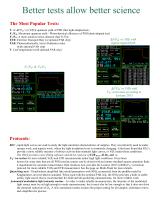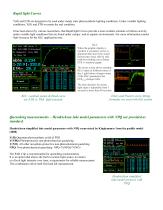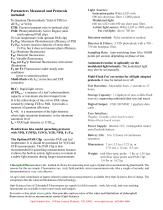
Catalog excerpts

Phone 603-883-4400 Fax: 603-883-4410 Email: sales@optisci.com Website: www.optisci.com OS1p Chlorophyll Fluorometer with FM’ correction according to Loriaux 2013 Pulse Modulated, field portable Best in Class - reliable plant stress measurement using light and dark adapted tests. Reliable - strict adherence to proven scientific protocols, and methods make the OS1p the instrument of choice Affordable - Y(II) or )F/FM’ and ETR measurements are included, as well as FV /FM , Rapid Light Curves, & Henrickson lake model quenching with NPQ Fast - measure plant stress in a few seconds, allowing non-destruction evaluation of large plant populations High Precision - FM’ correction according to Loriaux 2013 - Stable built-in actinic light source for more reliable measurements While Fv/Fm is the most used fluorescent measurement parameter, Y(II) or quantum yield of photosystem II, and ETR, are likely the more versatile measurements. These two parameters have successfully demonstrated the ability to measure more types of plant stress than Fv/Fm, and in some cases, detect stress earlier. Replacing the popular OS1-FL, the OS1p represents the next generation. This research grade instrument offers a number of new enhancements including: New measuring protocols for added flexibility, a color graphic touch screen for simple operation, a USB port, and MMC/SD data card technology that allows multiple instrument user management without compromise. In addition, OSI has developed an innovative PAR clip for use with the OS1p that exceeds previous industry designs. The PAR Clip includes a cosine corrected PAR sensor that is located to provide measurement of ambient light irradiation or internal actinic LED irradiation. Calibrations are made for sensor location, and light source type. It also includes a calibrated and reliable leaf temperature sensor. The mechanical design of the PAR Clip is also unique. This PAR clip is designed for one handed Easy to use - menu driven with color operation and it will not open at inappropriate times. graphic touch screen 8 Winn Avenue Hudson, NH 03051,
Open the catalog to page 1
Better tests allow better science The Most Popular Tests: Y: or )F/FM ’ or (Y(II)) quantum yield of PSII (fast light adapted test) FV/FM: Maximum quantum yield - Photochemical efficiency of PSII (dark-adapted test) FV/FO: A more sensitive stress detector than Fv/Fm. )F/FM’ or Y(II) with ETR: Electron Transport Rate (w/optional PAR clip) square topped flash PAR: Photosynthetically Active Radiation value (with optional PAR clip) T: Leaf temperature (with optional PAR clip) FV/FM & FV/FO )F/FM’ or Y(II) with FM’ correction according to Loriaux 2013 Protocols: RLC - rapid light curves are used...
Open the catalog to page 2
Rapid light Curves Y(II) and ETR are designed to be used under steady state photosynthetic lighting conditions. Under variable lighting conditions, Y(II) and ETR overstate the real condition. It has been shown by various researchers, that Rapid light Curves provide a more realistic estimate of rubisco activity under variable light conditions that are found under canopy, and in aquatic environments. For more information contact Opti-Sciences for the RLC application note. RLC When the graphic display is touched, a secondary screen is displayed that shows the actual fluorescence trace side by...
Open the catalog to page 3
Innovative PAR Clip Technology Advances The Opti-Science PAR Clip was created to improve upon previous industry designs. By developing a bottom opening PAR Clip, this new model prevents inappropriate opening when measuring leaves above the operators head, or when mounted on a tripod that occurs with some industry designs. As a result, the Opti-Science PAR Clip allows one handed operation, and eliminates two handed operation. This PAR light sensor is positioned to allow measurement of ambient PAR as well as PAR from internal actinic light sources. Special care must be taken when using...
Open the catalog to page 4
Innovative PAR Clip Sensor Location error In 2000, a researcher found that having a PAR sensor at a different plane from the leaf plane, and that is also laterally displaced from the center of measuring field, can produce an error in PAR measurement of up to 10%. PAR Sensor Location Error Top View Side View Fiber Optic Probe PAR or PPFD Sensor To correct for this error, Opti-Sciences calibrates the PAR at the leaf plane in the center of the measuring field. Leaf There is no significant error when measuring sun light. However, when internal actinic illuminators are used to drive...
Open the catalog to page 5
Saturation pulses used with modulated fluorometers are designed to close all PSII reaction centers. The maximum fluorescence intensity value, of the saturation flash, FM’, is used in most measurements including, quantum yield of PSII MPSII (also called Y(II) or )F /FM’ ), J (or ETR), and in all quenching protocol parameters. While it is possible to reduce or close all reaction centers in a properly dark adapted sample, with a relatively low amount of light, it has been found that in light adapted samples, with a high actinic light history, complete closure of all PSII reaction centers...
Open the catalog to page 6
Attention to Detail Data Management The OS1p provides a gigabyte of non-volatile flash memory designed to prevent data loss due to power interruption. Data Card The built-in MMC/SD data card system can be used with an unlimited number of fluorometer users to store individual measuring routines and individual data records. The data cards are very inexpensive and can store up to an additional gigabyte of information. Instrument settings, and experimental results can be automatically, an instantaneously set by each researcher, by loading the stored file from the data card. USB A small USB port...
Open the catalog to page 7
Parameters Measured and Protocols included: Y: Quantum Photosynthetic Yield of PSII (or )F/FM’ or Y(II)) ETR: Electron transport rate (w/optional clip) PAR: Photosynthetically Active Region value (with optional PAR clip) T: Leaf temperature (with optional PAR clip) FV/FM: Maximum Photochemical efficiency of PSII FV/FO: A more sensitive detector of stress than Fv/Fm, but it does not measure plant efficiency. FO: Minimum fluorescence FM: Maximal fluorescence FV: Variable fluorescence FMS (or FM’): Maximal fluorescence with actinic illumination FS (or F): Fluorescence under steady state...
Open the catalog to page 8All Opti-Sciences Inc catalogs and technical brochures
-
GFPIII
2 Pages
-
Lambda T
2 Pages
-
PGA
2 Pages
-
EGA60
2 Pages
-
EGA41
2 Pages
-
EGA30
2 Pages
-
SRS-SD 1000
4 Pages
-
ACE
10 Pages
-
AM350
2 Pages
-
LCpro-SD
6 Pages
-
LCi-SD
6 Pages
-
ACM-200plus
2 Pages
-
CCM-200plus
2 Pages
-
PSP32
9 Pages
-
PSK
14 Pages
-
Integrated Fluorometer iFL
16 Pages
-
OS5p+
14 Pages





















